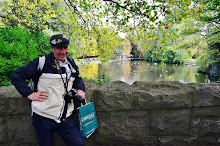LET THE MISERY BEGIN
Tunnels, that’s what this is about, that’s what I’m blaming,
not my own recklessness and innate curiousity.
I’m doing a house sit at a place called Stanwell Park, which
is directly below Stanwell Tops, a place made famous by Lawrence Hargrave, a
man who liked to stand at the top of steep slopes in odd shaped box kites or,
more correctly, an assemblage of four of them.
In fact, his whole life is like a story from a Boys Own book. After his father had moved to Australia from
England he failed to matriculate into law like his father but, instead, he
circumnavigated Australia in the Ellesmere, his first of six expeditions he
sailed on.
He next worked at the Sydney Observatory while getting
interesting in flight. He corresponded
with an American, Octave Chanute, who was influenced by him and later went on
to be highly influential in the Wright Brothers efforts.
He lived at Stanwell Park where his father had wisely
invested in land, including some mining areas, which provided him with a steady
income. His only son (of six children)
died at Gallipoli and Lawrence sadly died a couple of months later.
Otford Tunnel was my goal, one of eight originally on this
version of the southern railway line, eventually closed because the ventilation
was so poor that passengers were continually getting sick, but that was a long
time ago. The local government had plans
and announced that this would be part of a rail trail, but nothing has come of
it yet. The Otford name comes from where
Hargrave’s father emigrated from.
Today, with my headlight, I took a punt that I might be able
to ride my bike through, though I entered very tentatively; a wise choice as it
transpired. Past the graffiti surrounded
entrance I edged along. After stopping
and starting for the first 400 metres I conceded defeat and walked the entire
rest of the way.
The problem is that water has intervened; a creek runs
almost the entire length and there’s even a shower coming from the roof about
midway through, ravaging what’s left of the base and making the passageway very
difficult.
Behind me, a family I’d passed 20 minutes earlier kept up a
constant patter of chat which constantly echoed through the chamber, annoyingly
at times since I was trying to focus on the route. Initially, if you don’t have a light, it
really is pitch black and the floor is invisible until about the last 100
metres.
My relief when the end was near was palpable, through an old
gate that once blocked the exit but has been open for years. At last, I could see a rideable path –
whoopee!
The noisy group passed me as navigation was checked. It looked like roads weren’t too far away and
the Otford Railway Station was down there somewhere, though initially the
concrete trail went steeply skywards before flattening out and converting to a dirt
track with lovely gardens at its side and with glimpses of houses set among the
forest, seemingly with a road on the other side; it seemed hope was at hand.
Then it came time to make a decision; right to the road or
left to the station. I opted for Otford
Station, clambering down the steps on the steep path. No sooner had I got a rhythm up than a train
pulled into the station. Now my steps
had an urgency about them. Alas, the
train departed about 20 seconds before I made it to the platform. Obviously the driver hadn’t noted my waving
arm!
Now the choice was simple; ride back to base. I set Miss Direction and struggled up and
down the railway stairs before reaching the carpark where, at last, I could
straddle the saddle and get some motion into the wheels.
Miss Direction had said steep climb, but even I, a noted
ascent hater, had no trouble slow climbing up a scenic road full of lovely bush
in the flush of spring. Imagine my
surprise when I reached the top and found I’d come upon Stanwell Tops Lookout,
where hardly a parking spot was to be found.
It was Sunday after all.
Having lost my bidden somewhere in the tunnel I salivated
when I ordered a double scoop ice cream and then sat on a bench seat on this
delightful spring day and soaked up the expansive ocean view. An obviously older man struck up a
conversation, wanting to know if I was getting ready for Le Tour after checking
out my attire. I replied in the
affirmative, saying you had to start your training early.
Turns out he was 90, lived at Campbelltown, and drove out
here several times a week, sometimes twice in the same day. He said it was keeping him alive. There was a time when he’d been into cycling
too, had raced and coached one of his sons who’d won N.S.W. under 16’s and
other events. Sadly, he was estranged
from most of his family. I couldn’t help
but wonder why.
I then started reminiscing
about the last time I was here, when I did the Gong Ride.
The organizers were keeping batches at the top while the
road was cleared and about 400 of us started the descent. I was probably about twelfth away and
rocketed downhill, passing everyone, including the escort motorcycle! It was a wonderful adrenaline rush.
Today I was much more sedate and settled for closing in on a
car that wasn’t really in any hurry at all and cruised the rest of the way
before turning off to my house sit. I
could attach many labels to my day out, but none of them was “boring”!
Labels: bush walk, Otford, Stanwell Park, tunnel










.jpg)
.jpg)






.jpg)
.jpg)
.jpg)
.jpg)
.jpg)
.jpg)

